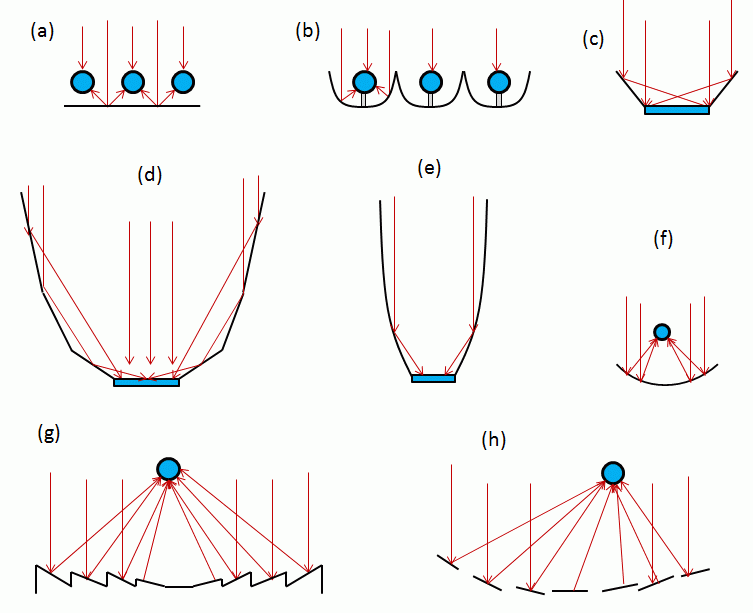2.2 Types and Elements of Concentrating Collectors
Any general setup for the conversion of the solar energy includes a receiver - a device that is able to convert the solar radiation into a different kind of energy. This can be either a heat absorber (to harvest thermal energy) or a photovoltaic cell (to convert light to electric energy). In the first case, the thermal radiation is absorbed to heat a medium (fluid), which transfers that absorbed energy to a generator. In the second case, light causes a photovoltaic effect in the material of the solar cell, which generates electric current. In both of these situations, the amount of energy available for the conversion is only as much as the solar source supplies per unit area of the converter.
If we need more energy for use, we have two options. The first option is to increase the system scale (for example by increasing the number of receivers). In other words, we have to expand the plant area, which would involve additional cost for construction, service, maintenance, and may require additional land, more materials, etc. It has been done to some extent, but sometimes it is not a sufficient measure to meet the energy demands, especially if land area is a constraint. The second option is to concentrate the radiation flux. This can be achieved by placing a concentrator (usually some kind of optical device) between the light source (sun) and the receiver. By common terminology, a solar collector is a sunlight processing system that includes a concentrator and a receiver in its setup; it is also characterized by aperture - the cross sectional area through which sunlight accesses the system.
The most common concentrators are reflectors (mirrors) and refractors (lenses), which modify and redirect the incident sunlight beam. The design of the concentrating optics varies. Some of the examples of concentrating collectors, which involve diversely shaped mirrors, are shown in Figure 2.3, as they applied to the solar-to-thermal energy conversion.

The process of light concentration implies first of all that the energy flux is increased due to confining it to a smaller area. This brings several important benefits:
- reaching higher temperatures for heat collectors;
- heat losses from the surface of the receiver are decreased because the receiving area is decreased;
- higher energy conversion rate can be achieved over smaller area.
Concentration implies confining solar radiation flux to a smaller area compared to original aperture.
There are two major classes of solar concentrators: imaging and non-imaging. Imaging concentrators are called imaging because they produce an optical image of the sun on the receiver. Non-imaging concentrators do not produce such an image, but rather disperse the light from the sun over the whole area of the receiver. Non-imaging concentrators have relatively low concentration ratio (<10) compared to the imaging concentrators.
All of the optical tools designed for manipulating sunlight for the purpose of its concentration and efficient utilization are based on the fundamental optics principles, which you may remember from physics courses. In case you need to refresh your knowledge of those fundamentals before we study the light concentration principles, please refer to the following reading and video:
Reading and Video Assignment
Web article: "Light Reflection and Refraction", Science Primer 2011-2013.
This webpage has a good explanatory video, which I suggest you to watch.
Out of the different types of concentrators listed above, mainly the following four technologies have been adopted for use in the utility scale CSP facilities [Mendelsohn et al., 2012]:
- Parabolic trough
- Solar tower
- Parabolic dish
- Linear Fresnel reflector
All of these are imaging concentrators which allow relatively high concentration temperatures: about 400 oC for parabolic troughs, up to 650 oC for Stirling dishes, and above 1000 oC for solar power towers. Just for comparison, non-imaging concentrators would work maximum up to 200 oC. These technologies will be introduced in more detail in Lessons 7 and 8 of this course.
There are also developments for non-imaging compound parabolic collectors (CPC) to be used at the utility scale for low-temperature applications [Baig et al., 2009], but this technology is not as widespread due to its moderate concentrating capabilities. Its flexibility with respect to using non-beam radiation and more relaxed technical requirements to positioning of concentrators are still attractive, so this technology will be also included in our consideration.
Concentrating photovoltaics is another technology class that uses concentrated light, but those devices will be covered separately in Lessons 5 and 6 of this course.
